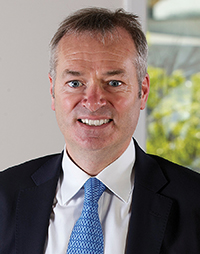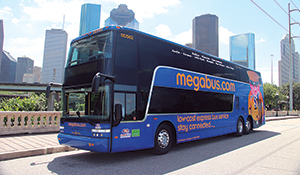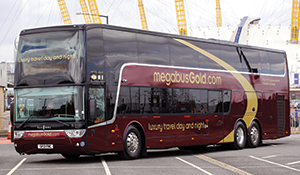
Martin Griffiths explains how and why the system has succeeded in the U.S.
By Doug Jack
Although Sir Brian Souter had the inspiration for the megabus.com coach operations, nowadays he is chairman of the Stagecoach Group. In line with British rules on corporate governance, management of the Group is now firmly in the hands of Martin Griffiths, who moved easily into the top position from his previously held finance director post.
—————————————————————————————————————————————
YOU MIGHT ALSO LIKE:
- Daimler at IAA: Why buses are so attractive
- Transports Publics Exhibition: No diesel please; we are French
- Solaris had a record year
—————————————————————————————————————————————
I recently asked Martin for an update on Stagecoach activities in North America, particularly how megabus.com was developing. He says the company is now active in 34 states, two Canadian provinces and Washington, D.C. The daily peak vehicle requirement is 274 coaches, but the fleet is a little larger than that, mainly for engineering purposes.

“Megabus.com in North America is the fastest growing part of the entire Stagecoach Group,” Griffiths says. “Revenue in the 2013-14 financial year was $177.9 million, versus $152.8 million on a like-for-like basis the previous year.”
Asked if megabus.com was unique in using double-decker coaches, Griffiths says it was the first company to use them on scheduled line run services, and that they have proved very popular.
“It is a specific product that we have developed with Van Hool,” he says. “Capital cost per seat is very important, and also the fuel burn per seat. The emissions per passenger per seat are the lowest of any form of intercity transport and that is a very important factor.”
He says one of the North American sister companies, Kerrville, now uses double-decker coaches on a commuter service. Small numbers are in use by other companies on charter and contract runs.
Griffiths says that Stagecoach had taken a different approach to providing intercity services in North America.
“Before we started in 2006, we noticed that express services were what we would call production led,” he says. “A coach would start on the east coast and make its way across the continent. It might stop at intermediate points in the middle of the night for passengers to board and deboard.”
He says it was a captive service for people who did not have cars.
“We asked how we could get modal shift if we introduced the right product,” Griffiths says. “There is not as strong a rail network in North America as in Europe, although there are some busy corridors. We wanted to introduce a concept that was customer led. Our target had to be the 92 percent of the population that had cars.”

“Americans and Canadians expect good service and demand value,” he adds. “They use the internet widely to find the best deals. We have found in previous research that our key market is motorists. Around 39 percent of megabus.com customers previously traveled by car; 14 percent by airlines; and 14 percent by train. The remainder came from trips that would not previously have taken place, and from various alternative coach operators.”

Griffiths notes that many megabus.com passengers are young people. While the older generation had wanted a driver’s license as soon as they came of age, and to be car owners, the new younger generation is more aware of the cost of motoring and of the environment.
Megabus.com services are popular with them because they have connectivity with free Wi-Fi and can work or stay in contact with friends.
—————————————————————————————————————————————
YOU MIGHT ALSO LIKE:
—————————————————————————————————————————————
Griffiths says the North East services are typically around four to five hours. In other areas, typical journey length is around eight hours.
There is very little scope for short distance routes under two hours, but there are some longer distance services of 12 to 16 hours and those are proving very successful.
I asked him about future plans for megabus.com in North America, realizing that it is a competitive market and that Stagecoach traditionally keeps plans under wraps until close to launch.
“We see tremendous ongoing potential,” he says. “We have 10 to 12 hubs and are very happy with the geographic footprint. However, when I look at the map, some other places look attractive. We have the people in place and the business model that works very well, so we will certainly explore more opportunities.”
The megabus.com model is focused on point to point intercity journeys. However, for a company to receive an FTA grant, it needs to feed into a national network supplied by an accredited company and to offer interlining. The accredited company provides in-kind match. The FTA acknowledges megabus.com as a company that can provide in-kind match. As a result, while not currently benefitting, megabus.com is in a position to work with other companies to increase rural connectivity in the future.
Martin also refers to megabus.com activities in Europe. There are services linking London, Amsterdam, Brussels, Paris, and more recently right through to Barcelona in the north of Spain. These are all operated by 49-foot tri-axle coaches, which Griffiths says cope very well with the old urban centers, right angled turns and other obstructions.
Last year, megabus.com services from the United Kingdom to the continent generated more than $11 million in sales and this looks set to rise as more routes are opened. Martin says that German coach services are opening up to deregulation and the French will be required to do the same under European law.
“While we have talked about megabus.com, we also have other strong parts of the business,” Griffiths says in conclusion. “We remain very positive about prospects in North America and are very committed.”
Doug Jack is with Transport Resources in the United Kingdom.
